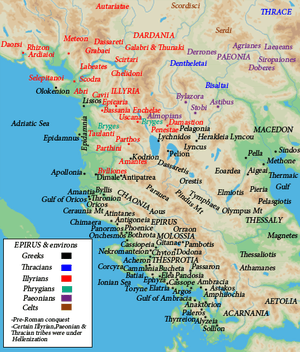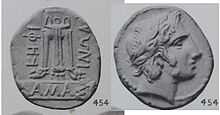Damastion

Damastion (Greek: Δαμάστιον) was an ancient city in the area of central Balkans. Various sites in Serbia[1] and Macedonia and Albania have been considered as the location of this ancient town.
The city was in the borderlands of Illyria and Paeonia, more on the side of the latter. The exact site of the city is not yet identified with certainty. Damastion is attested only in Strabo who says that the city had silver-mines.[2] However, he mentions Damastion without giving its position (VII, 7, 8; VIII, 6, 16).
Location

Damastion was issuing silver in the form of coins bearing the head of Apollo on the obverse and a tripod with the inscription "ΔΑΜΑΣΤΙΝΩΝ" on the reverse. These coins have been found in many places in the Balkans, mainly in south Serbia, east Macedonia, west Bulgaria, the Scutari in Albania and as far as Romania, Trieste and Corfu. They are dated in the 4th century BC. Most attempts to locate Damastion are based on the study of the coins and their distribution. One author, Dr Imhoof-Blumer, endeavoured to find modern derivatives of the name and assumed that Damesi, a village in Albania, could have been Damastion.[3] There are a number of other hypotheses[4][5] about its location somewhere near Resen in ancient Paionia,[6] modern Republic of Macedonia.
The most recent location that was proposed was at Serbian archaeological site Kale-Krševica, south-east of Vranje (southern Serbia) [7] where 5th-century BC foundations of an Ancient Greek urban town have been unearthed.[8][9]
Dr. Petar Popović from the Institute of Archeology in Belgrade says that Kale-Krševica could very likely be the city of Damastion.[9] He added that monumental building was found made from semicircular blocks 9m long and 3 m high. He estimated that only 5% was excavated and said that the town probably had 3.000 people.[10]
History
In 4th century BC the city (the Damastini) were subjects to king Bardyllis[11] and its inhabitants were called the Damastini (not a specific Illyrian tribe). The city was known in antiquity for its silver mines, whose exact location, like that of the city itself, is today unknown.[12][13] In the 431 BC Greeks from Aegina had colonised the city.[14] The circulation of the coins of Damastion included Dardania (Metohija and the Morava valley) and beyond, and to the west the southern Adriatic coast.[15] The city and its silver mines were captured by Philip II of Macedon after he defeated Dardanian King Bardylis.[16]
See also
References
- ↑ http://av.zrc-sazu.si/pdf/58/AV_58_Popovic.pdf
- ↑ Wilkes, J.J. The Illyrians, 1992, ISBN 0-631-19807-5, Page 223,"... Among the southern Illyrians the deposits which provided Damastion (Strabo 7.7, 8), somewhere in the Ohrid region, with a silver coinage may be the same ones that attracted Corinthian ..."
- ↑ May J.M.F. The coinage of Damastion and the lesser coinages of the Illyro-Paeonian region. Oxford University Press, London, 1939
- ↑ Barrington atlas of the Greek and Roman world: map-by-map directory, Tome 1,by Richard J. A. Talbert,page 758,near Resen?
- ↑ The Illyrians by John Wilkes,page 128,"north or northeast of ohrid"
- ↑ The Odrysian Kingdom of Thrace: Orpheus Unmasked (Oxford Monographs on Classical Archaeology) by Z. H. Archibald, 1998, ISBN 0-19-815047-4, page 107,"of Paion- ian Damastion"
- ↑ (Popovic, P., Kale-Krsevica excavations 2001-2004, Bulletin of the National Museum Vranje, 33: 25-49, 2005.)
- ↑ http://cat.inist.fr/?aModele=afficheN&cpsidt=20160361
- ↑ 9.0 9.1 http://www.politika.rs/rubrike/Kultura/Kale-iznova-iznenadjuje-nauchnike.lt.html
- ↑ "Damastion kod Bujanovca!?". Radio Televizija Srbije. 4 August 2014. Retrieved 5 September 2014.
- ↑ The Cambridge Ancient History Volume 6: The Fourth Century BC by D.M.Lewis, ISBN 0-521-23348-8, 1994, p.429 "Bardylis combined military and economic developments. His subjects, the Damastini, began to issue a fine silver coinage c. 395, which adopted a version of the standard and some emblems of"
- ↑ The Cambridge Ancient History Vol.6: The Fourth Century BC by D.M.Lewis, ISBN 0-521-23348-8, 1994, p.422: "... Silver was mined in antiquity by the Damastini to the east and the north east of Lake Ochrid.
- ↑ Wilkes, J.J. The Illyrians, 1992, ISBN 0-631-19807-5, p.128, "Nothing is so far known of the extraction of silver, and the location of Damastion, with its remarkable silver coinage, remains a mystery"...."
- ↑ In An Inventory of Archaic and Classical Poleis by Mogens Herman, ISBN 0-19-814099-1, 2004, "As a long-distance trading community, Aigina was not an active coloniser, but colonised Kydonia (no. 968) in 519, Adria (no. 75) c.C61, and Damastion in Illyria after 431 (Strabo 8.6.16)."
- ↑ The Illyrians - p.176 by J.J. Wilkes ISBN 0-631-19807-5
- ↑ The Role of Metals in Ancient Greek History, p.285 by Michail Yu Treister, ISBN 90-04-09917-4
| ||||||||||||||||||